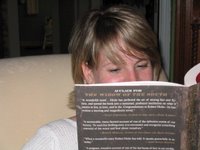
Professional Photographer Please!
One with the fuzzy lens!



My Mission...Not Impossible...Make Mississippi Read!

Professional Photographer Please!
One with the fuzzy lens!



We brought home a new edition to our family today. Sandy, originally named Julie, is settling in quite well, but we have yet to hear her purr. The helpful staff and volunteers gave us sound advice and she has used her new box without any oops. Now, she is resting at my feet, see pic below…
This is the ad for Sandy, and the nice volunteer told us she just got her picture on the website at noon today. We went in to get Rose, my husband wanted a cat that didn’t like competition, and I didn’t care. (He knows I would take them all!) Julie's story was heart breaking and we drove over an hour to see her and Rose...
Collierville Animal Services
Collierville, TN
901-457-2670
Cat
Domestic Short Hair - buff and white
Size: Medium
Age: Adult
Sex: Female
Notes: Now here's a story that will break your heart. A car pulls up early one morning, the occupant finds the front door unlocked, the lobby empty, and proceeds to throw a cat inside and speed away just as an employee comes in from the back. This poor baby huddled in a corner, scared half to death, as our employee tried to figure out WHAT had just happened. We have named her Julie; she is declawed and already spayed. Whoever did this doesn't deserve her anyway. She is safe and loved here and we will do whatever we can to find someone who will love her always...
Nothing is better than sitting in a cool theatre, watching a summer blockbuster; one gets a break from the heat and entertained at the same time. Well, after viewing Pirates of the Caribbean: Dead Man’s Chest, the second best thing is to read a nautical tale. This week I chose The Story of a Shipwrecked Sailor by Gabriel Garcia Marquez. This true story first appeared as a series of articles in a Colombian newspaper, El Espectador. Sailor Luis Velasco was tossed overboard the Colombian naval destroyer Caladas, during a routine trip from Mobile, Alabama, to Cartagena, Colombia. He was at sea, devoid of food and water, for ten days.
This week I chose The Story of a Shipwrecked Sailor by Gabriel Garcia Marquez. This true story first appeared as a series of articles in a Colombian newspaper, El Espectador. Sailor Luis Velasco was tossed overboard the Colombian naval destroyer Caladas, during a routine trip from Mobile, Alabama, to Cartagena, Colombia. He was at sea, devoid of food and water, for ten days.
Once on dry land, Velasco became an instant national hero, “kissed by beauty queens, made rich through publicity,” but unable to tell his real story. After a year of publicity rounds, sporting his unstoppable watch and inedible sneakers, he showed up on the steps of Bogota’s El Espectador.
At the time, the newspaper was in its infancy with a director, editor-in-chief and staff reporter all under the age of thirty. Colombia, ruled by military and social dictator General Gustavo Rojas Pinilla, played down the true events and Velasco’s vastly publicized story had a certain sugary taste.
Author Garcia Marquez was the lone reporter assigned Velasco’s story—a story, which eventually saw the demise of El Espectador, not because of Marquez’s writing ability (he became a Nobel winner in 1982) but rather Velasco’s proof, as in photographs, to damage Pinilla’s government.
Apparently, there was some contraband loaded on the destroyer’s deck, which added instability to the craft. Were they transporting atomic weapons? Not really, they loaded on the regime’s refrigerators, washers and dryers, televisions and air conditioners. So much so, the weight and balance was out of kilter, and the ship began to list.
After midnight, an order came from the loudspeaker, “All personnel to the port side.” At 11:30 the following day, the order again reissued. This time Velasco and shipmates were on watch, not safe in their bunks. At 11:50, one of the many forceful waves knocked some crates loose, and as they began to slide into the sea, eight sailors seeking shelter from the waves went with them.
On February 28, 1955, seven crewmembers lost their lives because, “ill-secured moral and political cargo,” repressed the large destroyer from maneuvering to save them.
This is the story of one man surviving ten grueling days at sea. These few paragraphs are just the beginning; it is up to you to read a budding master at his craft.
“Aye, ‘tis good reading to be sure.”
Tags: Booktalk
 “Submerged, I would always go off into a dreamy state. I had always loved Chagall’s Lovers in the Red Sky, his painting of an entwined couple soaring above rooftops, above the moon. The image would come to me each time I sank into the wave, the couple sometimes flying through a red sky but more often swimming in searing blue water.
“Submerged, I would always go off into a dreamy state. I had always loved Chagall’s Lovers in the Red Sky, his painting of an entwined couple soaring above rooftops, above the moon. The image would come to me each time I sank into the wave, the couple sometimes flying through a red sky but more often swimming in searing blue water. Other times I would think of the mermaid Chagall had painted, suspended above the water, above the trees, a flying mermaid, but without wings, and I would think of Thomas saying he envied mermaids who belonged to the sea and to the sky” p129 ~ Sue Monk Kidd
Other times I would think of the mermaid Chagall had painted, suspended above the water, above the trees, a flying mermaid, but without wings, and I would think of Thomas saying he envied mermaids who belonged to the sea and to the sky” p129 ~ Sue Monk Kidd
How effective is art in visualizing a mood if the reader is unfamiliar with the piece?
Pete and I toured the streets of Charlottetown, PEI today. Without order, we explored the marinas and discussed the architecture, when a small sign caught my attention. Located at the corner of two streets, the sign claimed, “local books ahead.” I hastily took hold of Pete and swung us ‘round the corner, my appetite whetted by imagined stories of local folklore and ghosts.
Upon entering, I cried out, “Where are your local books!” The jovial bookseller pointed me in the right direction and added his recommendations on the latest. As I shopped, he put on a fresh pot of coffee and the little book nook took on a heady scent.
My host, a cheeky old salt, with rousing beard and salaciously witty manners, had a Gordon’s Fisherman appearance. It is with professional curiosity I asked him which genre he preferred to read. He likes a good mystery or thriller, quick to point out the new Evanovich, but in truth, he leans less towards the genres and more towards the books of substance.
My question, “Would that be the substance of learning in non-fiction or the substance of literary fiction?”
My short Hemingwayish peddler said he enjoyed the writings of modern literary greats like Nobel Prize winner, Gabriel Garcia Marquez. As he named his favorites among Senor Marquez’s works, I thought it about time to tackle “Love in the Time of Cholera.” I mean RA is more effective when one actually reads the recommended books.
To this Papa I owe a gift. What recommendation can I possibly make as equal?
PEI's best bookstore is called The Reading Well.
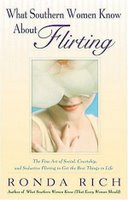 Ah, the art of flirting, all respectable Southern woman use this secret weapon every once in a while. It is one of the basic tools in our psyche, allowing us to obtain wants and needs in a fun, game-like manner. Flirting allows us to meet new people, charm the curmudgeons, and climb the business ladder. We know exactly when to use it and when to turn it off.
Ah, the art of flirting, all respectable Southern woman use this secret weapon every once in a while. It is one of the basic tools in our psyche, allowing us to obtain wants and needs in a fun, game-like manner. Flirting allows us to meet new people, charm the curmudgeons, and climb the business ladder. We know exactly when to use it and when to turn it off.
Margaret Mitchell got it right in Gone with the Wind, when Bonnie Blue hugs and kisses a delighted Daddy Rhett, and then asks for a pony. We, as Southern girls, are always Daddy’s little girl and carry this special gene for the flirting ability.
Our fathers activate this gene without consciously being aware. From the beginning, they melt when asked for something, if given the proper XXOOs lead-in. When they realize they may be spoiling us, they slow down rewards. We still get what we want, but we may wait a couple of months or years for satisfaction. This slow down is an opportunity to hone our skills for the hard sell, we know her as mother.
Ronda Rich fills her book, What Southern Women Know about Flirting, with wonderful Southern stories to demonstrate our God-given ability. One of my favorites involves the marital argument, which always occurs if one spouse thinks the other is “laying it on too thick” at a social event.
“…an Alabama-trained diva, and her husband left a Christmas party and immediately entered into an argument over her allure and charm, which had held most of the men at the party captivated. He thought she had taken too far her vow to always uphold social flirting as a critical attribute of Southern womanhood. As they argued, he swerved the car and looked up moments later to see a blue light flashing behind him.
He pulled over and a trooper approached the car. Since [the] husband, an attorney, had partaken of a couple of glasses of wine over the course of the evening, he was a bit nervous. After checking his license, the trooper said, ‘Sir, can you recite the alphabet for me?’
[The wife] leaned across her husband and said sweetly with a flutter of her eyelashes, ‘Now, officer, he couldn’t recite the alphabet when he was a senior at Ole Miss. Why would you expect that of him now?’ She finished the question with a delicious, flirtatious smile, and the officer laughed so hard that he dropped the whole matter.
As her chastised husband pulled the car back onto the road, she asked mischievously, ‘Now, what do you think of my charm?’”
Tags: Booktalk
| You are Betty Grable |
 The ulitmate girl next door You're the perfect girl for most guys Pretty yet approachable. Beautiful yet real. |
Author Elizabeth Berg received a letter in 2003 requesting she write the story of polio survivor, Pat Raming. The letter, written by Pat’s youngest daughter, Marianne Raming Burke, began, “I have no idea if you get this type of request often, however what is life without risks?”
Fiction writer Berg was ready to pass on the request, believing a non-fiction author would better suit Mrs. Burke’s needs. In the Author’s Note, Berg states, “I don’t like to take ideas from anyone—it goes best when I work alone.”
Yet, she could not stop looking at the photograph enclosed in the letter. The picture depicts a wheelchair-bound, young mother and sweet, curly-blonde daughter in front of their ranch home in California. “I was so taken with the lack of pity and the strength and joy I believed I saw on her face," Berg wrote in an e-mail.
Four days before Marianne’s birth in 1952, her mother contracted polio that placed her in an iron lung. Marianne, the youngest of three, believes she is the only baby to survive an iron lung birth. Marianne added, "They had her funeral ready and mine."
To make matters worse, Mr. Raming suggested they put their children up for adoption. The cause of their immediate divorce, Pat vehemently denied this insensitive request. It was now Pat’s responsibility to raise three children, all under the age of six, within her wheelchair-toting, portable lung. Although the book, We are All Welcome Here, is based on this true story, it is purely fictional. Berg, who likes to explore mother-daughter relationships in her novels, has chosen polio-stricken mother, Paige Dunn, and only child, Diana Dunn, as her main characters.
Although the book, We are All Welcome Here, is based on this true story, it is purely fictional. Berg, who likes to explore mother-daughter relationships in her novels, has chosen polio-stricken mother, Paige Dunn, and only child, Diana Dunn, as her main characters.
In the summer of 1964, 14-year-old Diana is the primary night caregiver to Paige. It’s another grueling summer in Tupelo, Mississippi, not only for the heat but also the simmering discourse between the races. There are three individuals in the Dunn household struggling with freedom issues: Paige, Diana, and the house cleaner, Peacie.
This is unlike any book Elizabeth Berg has written. She seems to rush through this story, as if she has a train to catch. The plot is predictable, yet, I can’t taint a woman who adds Elvis to her mix of characters. If anything, pick it up for the local flavor, it only takes a day to read.
Tags: Booktalk
In my quest to Make Mississippi Read, I wanted to explore a genre of the unfamiliar. I’ve read the Harry Potters and have tried to promote read-a-likes, but you can’t fool children. They know when you haven’t read a book. So, on special assignment and because this is a genre bookstores carry, I listened to fantasy on CD including Eragon by Christopher Paolini
So, on special assignment and because this is a genre bookstores carry, I listened to fantasy on CD including Eragon by Christopher Paolini
A Series of Unfortunate Events: The Grim Grotto by Lemony Snicket and a book by Dave Barry and Ridley Pearson titled Peter and the Starcatchers. I also read The Thief Lord by Funke and the new book Buried Fire by Jonathan Stroud.
This genre is not only fun but also addictive. I find it utterly amazing how writers dream up these new worlds. Along with new lands, they create outrageous names and unheard of creatures. They truly force their reader to take on the whole package that is their story or put it down. They present us with their own vocabulary which you must learn or face further chapters of confusion. This could be the reason many begin in a reality setting then fall through the infamous rabbit hole to a new world below.
These books pack excitement that keeps the pages turning. Many are full of end-of-the-chapter cliff hangers that yell at you to hold it; bathroom break later. The plot driven device is “good versus evil” and the hero is usually a child. Reader’s can really relate to the hero: a kid about their age, without all the answers, and willing to try stupidly brave acts. By sheer grit and determination this hero saves the fantasy world or conquers the evil that controls it. These books empower the child reader to take the steps necessary to become the hero.
Wherever there are children reading good fantasy, there will be controversy. One doesn’t occur without the other. I once had a whole family (5 kids ages 4-12) refuse to participate in our Summer Reading Program because the theme was “Fantasy Quest.” It is with heavy heart you listen to their reasons, present yours, and know that compromise is highly unlikely. Funny, they want their children to believe in an invisible force called God, but are afraid they will also believe in a fantasy world filled with witches and dragons. Let’s try trusting the kids to know the difference and act accordingly.
As we age, some things just naturally occur: we lose a little hair, we wrinkle a little around the eyes and we begin to hold the newspaper further away, as we read the obituary page. Yes, the aging process gently leads us to the daily reading of obituaries.
In our 20s and 30s, we just glance over the names of the newly departed. If we know the person, we skip to the last sentence to address the donation check or make visitation plans. In our late 30’s through early 50s, we start reading deeper into the announcement, looking to aid survivors by phone calls or food. When is it we start to focus on the age of the deceased as less a curiosity and more a barometer to our own longevity?
As you read obituaries, you start to wish they conveyed more of the person’s past spirit. The articles contain the basics, yet they miss the essences that made a life essential on earth. As Marilyn Johnson says in her new book, The Dead Beat, “A little life well lived is worth talking about.”
Author Johnson claims this is a good time to die. “Historians tell us we are living in the Golden Age of the Obituary.” Three of the biggest papers in America have reporters who report only on the departed—an assignment known fondly in the business as the “dead beat.”
The obituary section, usually assigned to insubordinate reporters as punishment, became an opportunity to weld ink pens filled with bittersweet sentiments. Banished to the basement, reporters figured no one would be reading their work so why not jazz it up. They even took to mock announcements, giving overly flourished eulogies, punctured with an atmosphere of hush, to saintly ghost that were never born.
Famous people require a reporter to research their lives and have the obituary written months in advance. These two-to-three, column-long missives called “canned obituaries” are ready when it is time for the second act.
Violet-eyed, Elizabeth Taylor’s obituary has been written and rewritten as the actress struggles with continuing health issues—multiple broken backs, life threatening pneumonias, hip replacements and now congestive heart failure. One eager reporter, in the early 90s, leaked her canned obit to the presses. After reading them she said, “The best reviews I ever had.”
Tags: Booktalk
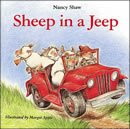 The Accelerated Reader (AR) program has an admirable mission and all public libraries want to help. As public institutions, we purchase materials for the public, but out of necessity, we have added extra AR paperbacks to the collection. Why? The demand is great and the elementary schools libraries do not allow children to check out.
The Accelerated Reader (AR) program has an admirable mission and all public libraries want to help. As public institutions, we purchase materials for the public, but out of necessity, we have added extra AR paperbacks to the collection. Why? The demand is great and the elementary schools libraries do not allow children to check out.
Picture little Betty coming home and telling mom she needs to read Sheep in a Jeep by Nancy Shaw for school. Time always of the essence, big Betty fires up the car and heads to the public library. They greet the happy librarian who takes little Betty by the hand and shows her Sheep in a Jeep and others in the sheep series. Meanwhile big Betty pulls out the AR list and begins the search for four more.
So, what is the big deal? Well, as the Betties leave with their five AR books, no time for any extra books, they pass Joe and Joe Jr. Yep, Joe has the same list and Sheep in a Jeep just departed with the Betties. Joe Jr. is in little Betty's class and eventually all these easy reading mates will visit the library before the week ends. The holds list for Sheep in a Jeep just jumped to fifteen.
It is a difficult situation to force a public library to buy multiple books because of school assignments. Really, with shelf space concerns, one hardback or two paperback copies of Sheep in a Jeep is enough. It might not be so bad if you are working with just one school. In our area there are three different elementary schools, which have bought, and brought different AR lists.
As a public library we have a special mission to supplement the school curriculum as much as feasibly possible. We just look unprofessional come the third, fourth, and so on kids we cannot serve because of demand. You can see why the schools prefer their books sit on their shelves.
My answer is to give these kids more time with AR books while in school. Provide 20 minutes in the morning and possibly take the test after lunch. We as librarians can also be sure to add silly, just for the heck of it, books to their AR pile.
"Miss Betty, have you read Don't Let the Pigeon Drive the Bus?"
Now, stand back, I’m about to step upon my soapbox.
Where is Marilyn Johnson’s editor? I love this book for many reasons, mostly the humor, the inside information, and the unusual subject. That said, how do I write a positive review when the author makes (elementary school) English mistakes?
Throughout her surprise chat with Billy Collins she misrepresents the possessive apostrophe with an extra “s.” On pages 45 & 46 she writes, “Collins’s anthology” and “Collins’s father.” Just how many Billy Collins(es) is she yapping to. She doesn’t capitalize titles like on page 44, “former poet laureate of the United States, Billy Collins.” This very sentence begins with “and” as follows. “And that was when I saw that that great stillness next to the window was the former,” add above ending.
Yes, I know what you are thinking, calling a spade a spade, aren’t I.
I just finished looking up the rule for apostrophes and am clearly in the wrong. Author Johnson has correctly placed the divet for which I became riled. Please excuse my ignorance. The rule I found gave the "Jones's bakery" as an example. If it was more than one it would be "Joneses' bakery."
I still stand by my other observations. I believe she should erase and rewrite the whole sentence on page 44. For example, "It was then, I noticed the great stillness to be no other than the former Poet Laureate of the United States, Billy Collins."
Stay tune for further updates...
Stepping down from soapbox to write more notes…
“The Independent, in an effort to dodge the desperate chronology, appends to its obituaries a little shaded box with the particulars of the subject’s birth, death, marriages, and positions, and a few other papers have followed.” Colin Haskin of Canada’s Globe and Mail, “calls it the Black Box, which is apt, even if the box it’s in isn’t black.”p37
The story of Opal Petty, on page 38, was institutionalized by her parents for three decades for wanting to dance.
Former Poet Laureate, Billy Collins, shares a subway car with the author by happenstance. She explains her trip and discovers Collins is also a fan of the obit. He tells her, his father used to call the New York Times obits, “the Irish sports page.”
“Historians tell us we are living in the Golden Age of the Obituaries.”p10
“It’s the best time ever to read obituaries, and I’m here to tell you, it’s a great time to die.”p12
“Obit writers are invisible, writing about people who have ceased to exist. If they wrote advance obituaries for some publication’s files, and they die before their subjects, they become people who no longer exist writing about people who no longer exist.”p14
Have to say that puts a whole new meaning into the term ghost writer.
“What is the correct collective noun for obituarists? A plague of obituarists? A wake of obituarists?”p16
I personally like, an exasperation of expiration writers, or headlines like, “The Obituarists Raise Money at the Death Benefit.” What about “Local Obit Writer’s hold 3-Day Death Camp”? Please excuse my bad taste.
Richard Pearson, Post obituary editor said, “God is my assignment editor.”p20
Picture a 1960s suburban cul-de-sac in Minnesota, teeming with young upwardly mobile families. This is the setting where Faith, mother of twin toddlers, feels lonely and unhappy. She is new to the neighborhood; she is even newer to Minnesota, having left her warm Texas life just three months earlier.
This has been a miserable wintry spring for Faith. Tied, no, chained to a house by fussy kids, icy roads, and ceaseless snow, the days are as exciting as watching ice melt. It doesn’t help that her pilot-husband is gone for days. If only she had family or even a friend in this frozen north, maybe things would be easier.
On this particular night, the twins are in bed and Faith is enjoying a book when the lights flicker then go out. Was it a real power outage or a prowler? To rule out the prowler, she opens the curtains to find a moonlit, wintry wonderland. Relief is short lived, as she catches stirring on the street. Swift movement, something launched, and then her window fills with a sloppy wet snowball.
Determined not to let these hoodlums get away with the blatant vandalism, Faith heads out the door; this time she takes a snowball in the shoulder and the night air fills with joyous laughter. This is how Faith meets the members of the Angry Housewives Eating Bon Bons Book Club—a close-knit group of four women who spend one day a month discussing books. Audrey is the audacious member always wearing, “necklines that plunge inches past propriety.” The tomboy honors go to the shortest member, Slip, who can walk on her hands like a circus acrobat. Merit is the shy, quiet one with a face like a china doll. Kari is the member that holds them all together with her wisdom and love.
This is how Faith meets the members of the Angry Housewives Eating Bon Bons Book Club—a close-knit group of four women who spend one day a month discussing books. Audrey is the audacious member always wearing, “necklines that plunge inches past propriety.” The tomboy honors go to the shortest member, Slip, who can walk on her hands like a circus acrobat. Merit is the shy, quiet one with a face like a china doll. Kari is the member that holds them all together with her wisdom and love.
So why do these five women harbor so much anger? Well, the name is not an indication of their true feelings. One drunken husband at a party says, “They’re just a bunch of angry housewives sitting around, eating bon bons.” The group gets together and decides it sounds like “the code name of a subversive group Gloria Stein and Sara Lee had put together.”
Angry Housewives Eating Bon Bons by Lorna Landvik is a delightful read. The book focuses less on the club’s reading material and more on their lives through three decades of meetings. It reminds me of the game Bunko, where most people come for the conversation not necessarily the game.
Tags: Booktalk
Hot-diggity-dog!
Como Elementary school has been awarded the 2006 Laura Bush Foundation Grant Award. I wrote this, while between jobs, during the month of November. This grant provides $5,000 dollars for books, and only children’s books, which we will not have to match.
This has been one of the most satisfying grants in my grant writing 10 years, not because it is the biggest, got one for $10,000 in 1998, but because I never thought I would get it. We are a huge Democrat county in an even larger Democratic State.
Part of the grant calls for more reading time, like the DEAR (Drop Everything And Read) program. Just another one of my sneaky plans to Make Mississippi Read! *evil laugh*
 Below is my Summer Reading List! I’m participating in Amanda's Weekly Zen book challenge. Her blog is…
Below is my Summer Reading List! I’m participating in Amanda's Weekly Zen book challenge. Her blog is…
http://ttbookjunkie.blogspot.com/
I may or may not read all of these since I read based on current mood. Right now, I’m in the mood for The Big Oyster, it being past 5:00pm and my stomach growling.
Non-Fiction Reads
1421: The Year China Discovered America by Gavin Menzies
A Fine Place to Daydream by Bill Barich
Affluenza by DeGraaf Wann Naylor
A Girl Named Zippy by Haven Kimmel
Guitar by Tim Brookes
Rats: History & Habitat of the City’s Most Unwanted Inhabitants by Robert Sullivan
She Got Up Off the Couch by Haven Kimmel
Silicon Snake Oil by Clifford Stoll
The Big Oyster: History on the Half Shell by Mark Kurlansky
The Dead Beat by Marilyn Johnson
The Glass Castle by Jeannette Walls
The Lost Painting by Jonathan Harr
The Tender Bar by JR Moehringer
What Southern Women Know about Flirting by Ronda Rich
You’re Wearing That? by Deborah Tannen
Professional Reads
Every Book Its Reader by Nicholas A. Basbanes
Growing a Reader from Birth by Diane McGuiness
Who Let the Blogs Out? By Biz Stone
Self Improvement Reads
Grammar Snobs are Great Big Meanies by June Casagrande
The Gremlins of Grammar by Toni Boyle and KD Sullivan
How to Knit Afghan Book by Barbara G. Walker
Miss Thistlebottom’s Hobgoblins by Theodore M. Bernstein
Stitch ‘N Bitch by Debbie Stoller
Fiction Reads
Angry Housewives Eating Bon Bons by Lorna Landvik
Arthur and George by Julian Barnes
Brilliant by Marne Davis Kellogg
Brookland by Emily Barton
Gilead by Marilynne Robinson
In This House of Brede by Rumer Godden
The Mermaid Chair by Sue Monk Kidd
Middlesex by Jeffrey Eugenides
Perfect by Marne Davis Kellogg
Priceless by Marne Davis Kellogg
Saturday by Ian McEwan
The Kitchen Madonna by Rumer Godden
We are All Welcome Here by Elizabeth Berg
Curiosity grabs me when I see an older title on the New York Times bestseller list. I want to find the origin that revives its standing in popular culture. I want to know what is driving thousands of readers to book stores or amazon.com. What compels them to pay paperback prices for something available in their local library’s used book sale bin for 50 cents?
Lately, it has been the utterance, however slight, by daytime talk show goddess, Oprah. It is amazing how Oprah drives book sales, like the mere mention of a childhood favorite, an interview with an unknown author, or book club selection commences cash registers around the world to ring. Come on, you can’t really read You: the Owner’s Manual, but there it is, 31 weeks on the bestseller list, fat ‘n happy with Oprah’s approval.
This was my first thought when I ran across In Cold Blood by Truman Capote on the paperback list. Hovering in the top three slots for 66 weeks, this book must be enjoying a desirable place in Oprah’s book club. Yet untrue, for Oprah’s current selection, Night by Elie Wiesel, is number one on the same list.
Movie tie-ins have the same effect, but to a lesser degree. The logical answer has to be the movie Capote directed by Bennett Miller.
Reading the first chapters of Capote’s In Cold Blood gives one the feel of literature past, an old fashion read, filled with elaborately descriptive characters and settings. This writing propels you to dive in, swim slow stretched laps, and then take refuge on a float, for you truly want to spend all day in the pool.
What makes this book so engrossing? Capote uses a style as old as Methuselah, a tease that makes us read more. Throughout the whole reading experience, we want to know why such a horrific crime occurs. We become Capote, the reporter. We push the questions; we search the clues; and we look at all the angles.
By watching the movie Capote with-in the same period as reading the book, one really gets inside Capote’s head. Capote identifies with Perry Smith, the confessed killer, struggling with a growing friendship he would rather dismiss. Capote said of the relationship:
It's as if Perry and I grew up in the same house. And one day he went out the back door and I went out the front.If you frequently watch cable network’s A & E shows like American Justice, Cold Case Files or City Confidential, you will love this book. It was the first of its kind, a non-fiction novel, which began the hugely successful true-crime genre. In honor of Truman Capote, they should rename the genre “Tru-crime.”
Tags: Booktalk
Capote’s setting in his book In Cold Blood reminds me of Grant Wood’s artwork. Picture his work stretched—take away the rolling hills—add more yellow, less green and you have Kansas; not his normal subject of Iowa. The black and white lithographs are more my vision, but it did begin with a warped American Gothic scene.
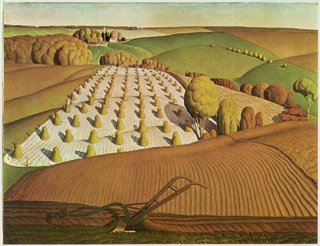
“That Monday, the sixteenth of November, 1959, was still another fine specimen of pheasant weather on the high wheat plains of western Kansas—a day gloriously bright-skied, as glittery as mica.”

“The village of Holcomb stands on the high wheat plains of western Kansas, a lonesome area that other Kansans call “out there.”
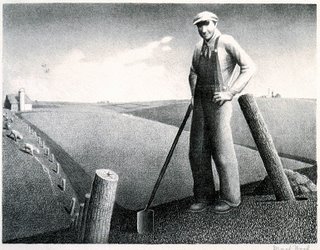
“Holcomb, too, can be seen from great distances. Not that there is much to see—simply an aimless congregation of buildings…”

“One of these barns was a mammoth Quonset hut; it brimmed with grain—Westland sorghum—and one of those housed a dark, pungent hill of milo…”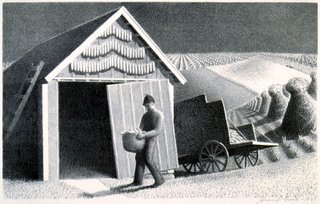
“It was ideal apple-eating weather; the whitest sunlight descended from the purest sky, and an easterly wind rustled, without ripping loose, the last of the leaves on the Chinese elms.”
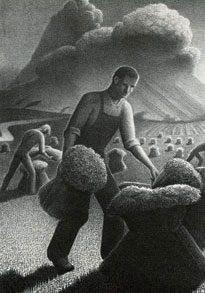 Mr. Clutter had an insurance man over the afternoon before his family was brutally murdered in the late night hours. To this salesaman he made the first and only “payment on a forty-thousand-dollar policy that in the event of death by accidental means, paid double indemnity.” Creepy, huh? Like the print above, hard working Mr. Clutter was preparing for the foreseeable storm.
Mr. Clutter had an insurance man over the afternoon before his family was brutally murdered in the late night hours. To this salesaman he made the first and only “payment on a forty-thousand-dollar policy that in the event of death by accidental means, paid double indemnity.” Creepy, huh? Like the print above, hard working Mr. Clutter was preparing for the foreseeable storm.
People who love reading usually start at an early age. My mother took us regularly to the library where favorites like Where the Wild Things Are and The Hungry Caterpillar fueled my imagination.
What happened to reading for fun in my teenage years? Was I too cool to read? Was I working excessively and lacking the time? Was it the constant assignment anxiety associated with deciphering the classics?
Something happened that made me afraid to read, a self-doubt crept in, my teenage brain wasn’t smart enough.
Movies were my salvation, a threshold into reading. I no longer trusted the visions conjured from reading and lazily relied on the cinema. Simply, I saw the movie then picked up the book. If I didn’t recognize any visual clues, settings or characters, I would toss the book. I didn’t get it.
Watching Capote last night, led to this embarrassing confession. I’m currently reading In Cold Blood which I started two nights ago. Visualizing settings and remembering characters is a snap, unlike my befuddled teenage self.
This is important in my quest to encourage Mississippi readers. Books can be humbling and make you feel inadequate. Teenagers face these feelings everyday from a variety of sources. Let us stop including books in a long list of educational bullies. What can we do to help? Well, we can stop being tightwads
What can we do to help? Well, we can stop being tightwads  and replace books made into movies with new movie cover releases. Yes, I think it silly, you can buy Brokeback Mountain as a stand-alone book rather than hand the patron Annie Proulx’s Close Range.
and replace books made into movies with new movie cover releases. Yes, I think it silly, you can buy Brokeback Mountain as a stand-alone book rather than hand the patron Annie Proulx’s Close Range.
Teachers, why not assign some books for pleasure reading like the DEAR, drop everything and read, program. Coaches, have you heard of “one book, one team” reading? In my academic position, marketing movie/book discussion programs may be a viable link to our young adults.
Oh, and lets not forget the easy displays like "Seen the Movie, Read the Book" or "Don't Judge a Book by its Movie!"
We pitch books today for our Reading Round Table, a group of retirees and staff, which meets during the fall and spring semesters. I’m going to try my best to get some readable non-fiction on the list. The suggestions should be available in paperback form.
A Year of Magical Thinking by Joan Didion
Devil in the White City by Erik Larson
Marley and Me by John Grogan
Rising Tide by John Barry
Wish me luck. ;-)
My booktalk for Sweet and Low doesn’t do the book justice. I loved the book and that really did not translate in the article. My idea was to talk about Rich Cohen’s style of writing and correlate it to the Sweet ‘N Low product. Why didn't I do that?
He writes a fascinating paragraph and then ends with a line of humor, sarcasm or profound thought. Like his family's product, sweet with a slight aftertaste, and yes, sometimes bitter.
You really feel Cohen has been waiting all his life to tell this family saga:
“I sometimes think a family is no more than a collection of such stories, a chronicle that locks you down like the safety bar that crosses your lap before the roller-coaster leaves the platform, without which you would fly away in the turns.”
Read the description of his grandfather and inventor of SnL, Ben:
“He finished first in his class. He was the valedictorian. He gave a speech about man and law. He rented an office on Broadway. He hung out his shingle. There were no clients. No work. He sat for hours, days, weeks. It was the Depression. He walked about the city. He followed the streets. In these years before Betty (wife) and the hassle and complications of family, Ben was a question mark. No parents, no siblings, no friends. Like the best Americans, he was free to invent himself.”
I love Cohen’s thoughts on being the baby in the family:
“I am the youngest in my own family, and I think, to a large extent, the youngest is almost always without blame, because the show was already going when we get there.”
Cohen does an independent taste test of the three artificial sweeteners on the market and this is what he says about SnL:
“Wow, that mother kicks! Taste like cancer. Those poor rats! The aftertaste drags you to the mat. Like the balloon payment that comes at the end of the financing plan. Was the Camaro really worth it?”
He has this to say about the leading competitor:
“Splenda is not just another sweetener. It is sugar remade, a molecule from God, put up on blocks, painted, and thrown back on the market.”
This is truly a fun book and I hope others pick it up despite my blah booktalk. :-)
Ben Eisenstadt is “part of that special breed of Americans—orphans, mongrels, mutts—responsible for no one but himself.” Growing up in turn-of-the-century Brooklyn, eight-year-old Ben works in his uncle’s tea bag factory from sunrise to sunset. This tough kid, with slouch-brimmed hat and chewed toothpick, eventually becomes the inventor of Sweet ‘N Low.
While working, Ben attends school and eventually becomes a lawyer. He attracts beautiful wife, Betty, ready to ride on the coat tails of his future success. Unfortunately, the Great Depression hits and Ben faces work as kitchen help in Betty’s family business. He enjoys local fame as the only busboy/lawyer in New York.
It’s in one of these shabby family diners where the idea to package sugar starts. Betty complains about the mess involved in sugar dispensers and bowls. The dispensers clog easily and the bowls are unsanitary because of the shared spoon usage. Ben asks, “What if the sugar was packaged separately, in little pouches?”
He purchases one of his uncle’s old tea bag machines and sets it up for sugar. We could stop here, with Ben’s success; unfortunately, Ben did not patent his machine. Hoping for a contract, he invites the leaders of Domino’s sugar to view his contraption. After two weeks of waiting, Ben finally discovers they are packing sugar, but with their own machines.
Sweet and Low by Rich Cohen mixes memoir, humor, and  history as the story of his family’s business unfolds. This unauthorized true story, as seen through the eyes of a disinherited family member, reminds me of the cast in Neil Simon's play, "Lost in Yonkers": a Jewish family complete with one neurotic mother, miserly father, golden-boy son, recluse daughter, and a daughter with moxie, or in this case, Cohen’s mother.
history as the story of his family’s business unfolds. This unauthorized true story, as seen through the eyes of a disinherited family member, reminds me of the cast in Neil Simon's play, "Lost in Yonkers": a Jewish family complete with one neurotic mother, miserly father, golden-boy son, recluse daughter, and a daughter with moxie, or in this case, Cohen’s mother.
The author tells this incredible story in three parts. The first part consists of a brief history of Brooklyn and Sweet ‘N Low’s humble beginnings. The second part relates how mobsters infiltrate the factory and launder millions of dollars through phony invoices. The last part concentrates on the disinheritance of the Cohen family and Sweet ‘N Low’s market loss.
Cohen, contributing editor of Rolling Stones Magazine, has waited all his life to tell his family’s story. Just like the product that made his grandfather rich, the story is sweet with a little bitter aftertaste.
Tags: Booktalk
When you reflect on your childhood, do you remember your Mom reading to you before bedtime? Did a teacher share Little House on the Prairie or Charlotte’s Web with your entire class? Was there a funny story told every holiday about your dad or the wacky aunt? I bet there was.
It is within our human structure that we crave these interactions with others through stories. As infants, we first seek out the calming nature of our mother’s voice. Through oral stories, we learn morals and basic vocabulary. As we age, we continually build our vocabulary in order to communicate effectively. This is one reason to continue to read-aloud even after the age of eight.
Last year I did an informal study on what the kids were reading and enjoying at our library. The survey was purely qualitative and the sample skewed for I only asked kids that came into our building for one week. The results pointed to a certain teacher’s daily reading aloud of one book.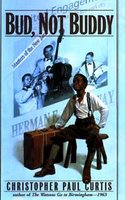 Bud Not Buddy by Christopher Paul Curtis was the unanimous favorite among Como Elementary students. Each child I talked with remembered different plot lines and humorous situations, to the point of retelling them with great enthusiasm. Why? They felt special being read to and it showed.
Bud Not Buddy by Christopher Paul Curtis was the unanimous favorite among Como Elementary students. Each child I talked with remembered different plot lines and humorous situations, to the point of retelling them with great enthusiasm. Why? They felt special being read to and it showed.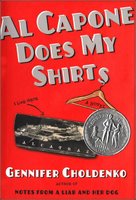
The world is full of great read-alouds, the key is matching the person with the right book. For the book Al Capone Does My Shirts by Gennifer Choldenko, I suggest a male reader. Main character and narrator, 12-year-old Moose Flanagan just calls out for a male voice.
This Newbery Honor book is set on the island of Alcatraz during the 1935 depression. The Flanagans hope to change their life for the better as Father works two shifts and Mother gives piano lessons. Moose meanwhile is missing baseball because he’s stuck baby-sitting his 16-year-old autistic sister.
Conflict is just around the corner, literally with Piper, the Warden’s daughter next door. Miss Piper has a knack for contriving moneymaking schemes that tend to go sour. Her latest project is convincing the whole class Al Capone will do their laundry for a nickel.
Word of caution; always read the book first. It is embarrassing when words pop up you don’t know, can’t pronounce or find inappropriate for the age group. It is best to buy the book so you can mark changes in the margin. What! A librarian just said mark up a book! Yeah, well not the library copy, please.
Tags: Booktalk

Everybody Dance!
You may remember the name "Tunica" from a 60 Minutes report in the late '80s or early '90s. At the time of the report, Tunica County ranked poorest county in the nation. Things have changed tremendously since the casinos came to town. They have a wonderful museum, library, and airport serving tourist and locals. Unfortunately, they still carry a high rate of illiteracy that needs eradication.
Thanks Tunica Times for allowing me the chance to
Make Mississippi Read!
Early in Ralph Helfer’s career, a Hollywood studio approached him to offer work as a stuntman. “Sure,” was his automatic reply before they explained the dangerous stunt, “We want you to pretend you are a lion tamer and work a male lion on a pedestal.”
Prior to this proposition, Ralph established himself as a fearless stuntman by handling rattlesnakes and scorpions in earlier productions. Well sort of, he just happens to be the only soul left standing in a room full of unpredictable creatures when a director hollers, “Action!”
The day of the shoot, Ralph meets the trainer. A rough man described as a “Bullderm” chewing, western type: completely messy, uncouth, and unethical with animals. A man preferring to use fear and sheer brute strength to control animals like his lion, Rex.
With a squirt of juice on the ground the trainer asks, “When do these people pay us?”
Ralph, shakes his head uncertain, and then inquires about the lion’s mood. The handler cocks back and says, “Well, okay, I guess.”
The instructions seem easy enough: get Rex to jump on a pedestal, cuff his paw, and snarl at you. (Piece of cake!) The handler then gives Ralph all the hand signals needed and lets him memorize the movements, but without Rex.
Fresh from wardrobe, Ralph ridiculously sports a blue and gold epaulet costume and long leather whip. He then takes his mark, which feels a little too close to the pedestal, and the director bellows, “Action!” With the gate open, Rex saunters into the cage, barely acknowledging Ralph and sits on his haunches.
Ralph has to snap the whip to rouse him, and then proceeds to do hand signals. Rex reluctantly “acts” the scene through and the director hollers, “Cut!”
“That was great, son. Let’s do it again.”
The next take, sends Ralph to the emergency room, unconscious and broken. From that horrible encounter, Ralph vows to learn a better way to treat animals, using respect and love. He coins his new technique “affection training” and smothers his animals with praises when they do well.
He gets another chance when Zamba, a lion cub abandoned near the Zambezi River, enters his life. You will laugh and cry reading, Zamba: the True Story of the Greatest Lion That Ever Lived by Ralph Helfer. It is full of narrow escapes and surprises, as Ralph evolves into the “Lion Whisperer.”
Tags: Booktalk
The plagiarism, which occurred in Opal Mehta by author Kaavya Viswanathan, has really got me thinking. Just how easy is it to claim something as original though?
Viswanathan has already admitted some of the work is word-for-word from Megan McCafferty. She being a Harvard graduate should know better…
I have a similar annoyance with a sentence I wrote on this blog February 26th. My sentence, found at the bottom of the entry, is…For when the child’s bedtime prayer becomes the adult’s touchstone in crises, habits have meaning.
I know exactly where the idea came from. So many truths came from A Year of Magical Thinking that I remember relating them to other books read around that time. Is this sentence word-for-word from Didion’s book or did I write original text? I really don’t know.
Why didn’t Viswanathan reread McCafferty? She had to know things sounded a little familiar. You had better believe if I was publishing a book I would reread Didion to see if my memory was word-for-word.
Plagiarism is a form of stealing and Viswanathan is a thief. Am I for publishing that sentence on Maggie Reads without researching the origin?
As the weather warms, most of us long to be in the great outdoors. My idea of heaven is lying on a blanket and staring into the warm night sky, being pleasantly surprised to catch a shooting star or satellite.
As you can imagine, I have developed a taste for astronomy books. They are tough to purchase though, as with the vastness of space, the books tend to have too much material and feel textbook heavy. Most publishers break 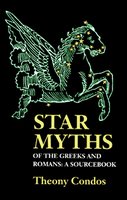 astronomy into smaller pieces like stars, planets, or solar systems. It is next to impossible to find a book dealing with Greek myths and the constellations.
astronomy into smaller pieces like stars, planets, or solar systems. It is next to impossible to find a book dealing with Greek myths and the constellations.
From experience, the books with constellational Greek myths are far and few. The last one purchased, Star Myths by Theony Condos, was so dry I ended up dreaming of stars.
Imagine my delight finding Greek myths included in the 2004 book titled  Night Sky Atlas by Robin Scagell. This spiral book, appropriate for all ages, includes a two-page layout of the monthly skies and easy explanations of celestial concepts. The adult version, Stars and Planets by Ian Ridpath, delves more into telescopes and positions of the planets, using a strip diagram to the year 2012. As with the children’s book it follows a monthly chart format, allowing you to discover which planets might be visible in the May skies before venturing out.
Night Sky Atlas by Robin Scagell. This spiral book, appropriate for all ages, includes a two-page layout of the monthly skies and easy explanations of celestial concepts. The adult version, Stars and Planets by Ian Ridpath, delves more into telescopes and positions of the planets, using a strip diagram to the year 2012. As with the children’s book it follows a monthly chart format, allowing you to discover which planets might be visible in the May skies before venturing out.
My husband and I are currently using a third copy of Stars and Planets,  having literally worn out the first two. We don’t leave home without it either. Our copy has traveled with us to Alaska, Nova Scotia and Ireland just to name a few places. Just like life, the night sky is slightly different when seen from another perspective.
having literally worn out the first two. We don’t leave home without it either. Our copy has traveled with us to Alaska, Nova Scotia and Ireland just to name a few places. Just like life, the night sky is slightly different when seen from another perspective.
Tags: Booktalk
 It's hard to see, but those little blue dots are Indigo Buntings! There were around 20 in the drive way when I got home this morning, a mix of males and females. So why just three and all male? Well, let's just say I'm loud. These brave souls ventured out after an hours wait! ;-)
It's hard to see, but those little blue dots are Indigo Buntings! There were around 20 in the drive way when I got home this morning, a mix of males and females. So why just three and all male? Well, let's just say I'm loud. These brave souls ventured out after an hours wait! ;-)
In March of 1985, I handed an engagement ring back to my stunned ex-fiancée and walked away. I remember the day as bitter cold just like my heart. Last year I attended my 20th high school reunion, where I would once again face the young man of my serious youth. I was ready for my “I’m sorry” speech when classmates informed me he would not be there.
This is my personal story but it is in no way unique. Many people for one reason or another leave their first loves and go out into the world alone. Others marry their high school or college sweethearts and enjoy long lives together. My parents are perfect examples having been the best of friends since Kindergarten.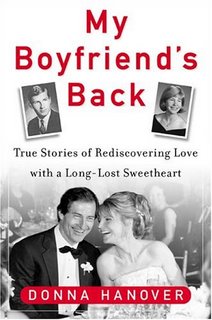
So you ask, what does this have to do with books? Well, I picked my reunion weekend to read the 2005, My Boyfriend’s Back: True Stories of Rediscovering Love with a Long-Lost Sweetheart by Donna Hanover. The author herself rekindles a college romance after thirty years apart. The familiarity she experiences with old friend Ed is akin to the magic of falling back into step with someone as if time hasn’t elapsed. This comfortable level of trust can enhance an old relationship and lead to a later in life matrimony.
While reading the book I kept picturing the end of the movie, “When 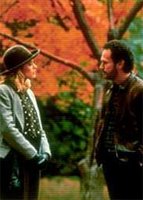 Harry Met Sally”. The movie ends with different couples telling how they were once sweethearts torn apart then much later reunited. This is the book’s premise, loads of real life reconnections peppered with psychological explanations. I have to fault Hanover in one respect. She uses each story to point out that childhood or young adult friends make for better relationships than some obvious stranger does. I get the feeling she has some trust issues.
Harry Met Sally”. The movie ends with different couples telling how they were once sweethearts torn apart then much later reunited. This is the book’s premise, loads of real life reconnections peppered with psychological explanations. I have to fault Hanover in one respect. She uses each story to point out that childhood or young adult friends make for better relationships than some obvious stranger does. I get the feeling she has some trust issues.
Tags: Booktalk
I’m currently reading Zamba by Ralph Helfer and I must write these paragraphs before I get too far in and lose them…
“For some reason, Zamba’s behavior was appalling that evening. Everything that could have gone wrong, did. As soon as we got there, he spotted the lady’s artificial rabbit skin coat – and attacked it, giving it quite a thrashing. When I finally got it away from him, it was ripped and torn to pieces. Personally, I didn’t mind, but once he had finished “killing the rabbit,” he proceeded to pee on the furniture! As dinner was served, he gave an explosive sneeze and a shake, thoroughly spraying the meal with lion snot. And during the dinner, he wandered off into the kitchen and helped himself to a drink from the punch bowl.
Although our hosts were gracious, I couldn’t wait to get him out of there, and I said our good-byes with a palpable sense of relief. Unfortunately, Zamba wasn’t through. On the way out, he pinned their Great Dane to the floor and wouldn’t let him up. They thought he was going to kill their pet! Needless to say, we weren’t asked back.”
Oh, I forgot to mention Zamba, the dinner guest, is actually a full grown, 500-pound lion. Did he get the head of the table honors? ;-)
As you may guess, I read plenty of books, combining work and pleasure. With the abundance also comes confusion, they tend to meld together and I need tricks to tell them apart. One trick I would like to share helps me remember the basics of juvenile historical fiction. When I refer to the word juvenile, I mean a reading level appropriate for fourth through eighth graders.
Everyone knows ABCs, 123s, and the three Rs (reading, writing, & arithmetic) refer to the basics for learning. The three Ks (Karen Hesse, Karen Cushman & Katherine Paterson) remind me of the basics of juvenile historical fiction. The three Ks are excellent authors who will hook any child, with a taste for the past, into reading. However, the Ks are not an inclusive list, just an entry point for the novice reader. Karen Hesse and Katherine Paterson are extremely important to the three Ks for they include books to entice young male readers. Karen Hesse has written a sea-faring tale based on the logbooks of Captain Cook titled Stowaway.
Karen Hesse and Katherine Paterson are extremely important to the three Ks for they include books to entice young male readers. Karen Hesse has written a sea-faring tale based on the logbooks of Captain Cook titled Stowaway.
Eleven-year-old Nicholas stows away on Captain Cook’s vessel Endeavor, living with the livestock until his discovery. To far from shore to send him swimming, Nicholas becomes the lowest member of the crew. The story, complete with sea charts and based in fact, will have your reader saying, “Aye-Aye.” Katherine Paterson’s Jip begins in the pre-civil war north sympathetic to runaway slaves. Young Jip’s earliest memory is falling from a moving horse cart, resulting in amnesia. Unsure who his parents are or where he is from, Jip becomes a farm hand. Then one day a stranger rides into town and claims Jip as his very own and the real trouble begins.
Katherine Paterson’s Jip begins in the pre-civil war north sympathetic to runaway slaves. Young Jip’s earliest memory is falling from a moving horse cart, resulting in amnesia. Unsure who his parents are or where he is from, Jip becomes a farm hand. Then one day a stranger rides into town and claims Jip as his very own and the real trouble begins. It is fair to say Karen Cushman has found her niche in historical fiction, from the independent minded female perspective. The main characters in Catherine, Called Birdy, Midwife’s Apprentice, and Rodzina are so well developed you not only live the historical eras but also sigh when the books end. No mindless girls for Cushman, she fills her characters with vim and vigor. These are perfect for that sassy daughter seeking adventure.
It is fair to say Karen Cushman has found her niche in historical fiction, from the independent minded female perspective. The main characters in Catherine, Called Birdy, Midwife’s Apprentice, and Rodzina are so well developed you not only live the historical eras but also sigh when the books end. No mindless girls for Cushman, she fills her characters with vim and vigor. These are perfect for that sassy daughter seeking adventure.
Other historical books by the three Ks include Preacher’s Boy, Lyddie, and Out of the Dust. Caution, these authors also write realistic fiction: so consult a librarian or salesperson if you have questions. By remembering the three Ks, you won’t go wrong recommending them to young history buffs.
Tags: Booktalk
Book discussion this past Monday centered on Harold Kushner’s Living a Life that Matters. The event, led by Dr. Chuck Strong, poised tough questions of the audience. He led with, “What type of person are you?” then pulled back to let us reflect on the question. Well, what a question and I’m not sure I could answer it. I imagine I could pull myself out of a set of categories, but the categories would be too rigid, meaning I’m apt to change depending on the circumstances. What?
Well, what a question and I’m not sure I could answer it. I imagine I could pull myself out of a set of categories, but the categories would be too rigid, meaning I’m apt to change depending on the circumstances. What?
Let’s examine honesty. I was too honest as a child and my mother reined me in constantly. I didn’t realize that my spouting opinions could hurt feelings. So, I learned the art of “little white lies” as a socially more acceptable persona. I don’t feel any less honest from the technique because I truly enjoy making people happy.
The group also focused on leaders and the compromises they make: in specific, recognition for accomplishments that had to involve a little bad with the good. Why? They threw a nice soirée for me when I left Como and I felt it was because of my good deeds. I was embarrassed but also elated that people even noticed my work.
It was a wonderful discussion and Dr. Strong was an excellent facilitator. Ah, the joys of chatting-up a thought provoking book.
“He is eighty-six years old, his eyes appear bewilderingly large behind Coke-bottle lenses, and most of his teeth are gone…He says he remembers the soldiers touching the columned mansions of Mississippi during the civil war, remembers eating crawfish in Louisiana, and collard greens and okra. He remembers crossing the languorous river that flows between Mississippi and Louisiana in a canoe.”
Can you picture a setting, a certain time period, say early nineteen hundreds? The man is definitely in the South, right? Reread the quoted passage and see if your mind’s eye becomes clearer.
This quote is from the book, Mississippi in Africa by Alan Huffman. Author Huffman is interviewing a man in Liberia, Africa in the year 2001. He is just one of many descendants of slaves given their freedom by plantation owner, Isaac Ross, Jr. in 1838.
Author Huffman is interviewing a man in Liberia, Africa in the year 2001. He is just one of many descendants of slaves given their freedom by plantation owner, Isaac Ross, Jr. in 1838.
This 86 year-old man may be optically challenged, but his mind is said to be sharp. He is remembering an easier life before the civil war of 1990: time when Liberia was controlled by his ancestors from America. He remembers the giant plantation homes where coffee and sugar were cash crops. He speaks of a river that separates the Mississippi and Louisiana settlements in the African county of Sinoe.
This book relates the incredible story you may have heard growing up in Mississippi. An 1845 fire engulfs a mansion called Prospect Hill in Jefferson County, MS and takes the life of “little Martha Richardson”. A fire said to have been set by angry slaves. Slaves that were granted freedom in Isaac Ross’ 1838 will, but contested by grandson Isaac Ross Wade.
Huffman is on a quest to find the real story behind this legend; a journey that begins in Mississippi history, and travels through to current day Liberia, and then back to the answer in Mississippi. If you like Southern history or current politics this book is for you. A fine addition to any Mississippian’s bookshelf.
Tags: Booktalk
Around the age of ten, Mother allowed me to spend the night with my new friend Suzanne. A huge event because Suzanne’s family lived in a brand new, paint-still-drying house, and I being ten didn’t get out much.
As we were getting ready for bed, Suzanne’s mom pops her head in and says, “When you settle down I’ll tell you a story.” Suzanne began to ham it up, “This is the best story!”, “You will want to tell everyone!”, “Mom will have you in stitches!” and so on like a Barnum and Bailey circus barker. Therefore, I calmed down as fast as anyone full of popcorn and coke, could.
With our feet tucked in and the covers to our chins, Suzanne’s mom commences with the story…There is a family with twin sons. One son is an eternal optimist and the other a perpetual pessimist…Brief intermission to allow for definitions…
Well, a local doctor claims he can cure the boys. He fills one room full of toys and another full of manure. The doctor leads the brothers down a long hallway and places them in the separate rooms: optimist with manure and pessimist amongst the toys. Before five minutes are up, the pessimist is screaming and wailing in his room.
Both parents rush down the hall to his aid. After opening the door, the pessimist starts complaining about the broken toys, and the lack of a playmate. Some toys are too small for him and some require assembling, etc.
The parents then realize their other son is awful quiet in his room. Fearing the worst, they inch open the door and are almost hit in the face with manure. Here they see their optimistic son digging furiously like a dog. Upon seeing them at the door the son shouts, “Throw me a shovel! With all this manure, there’s bound to be a pony!”
Rosamund Stone Zander and Benjamin Zander, will have you shouting, “Where’s the pony!” after reading their new book The Art of Possibility. This husband and wife super duo has learned to solve problems with the left sides of their brains. Problem solving that is “outside the box” and lends well to any professional or personal life.
If the Zander name sounds familiar, good, Benjamin is the current conductor for the Boston Philharmonic Orchestra and wife Rosamund is a noted psychotherapist. She is also a budding artist and when the couple has trouble at work, she literally draws possible solutions. Let this book draw you in and show you new roads less fret with manure.
Tags: Booktalk
